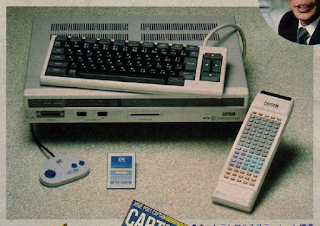 |
| A complete NTT CAPTAIN Multi-Station system, with an unconnected keyboard, an unconnected joypad, a good view of its massive remote controller and an IC card (picture from MSX Magazine 1988/01) |
Some people in MSX's community calls this machine as only "CAPTAIN", it's good to notice that CAPTAIN is a videotex system (the acronym means Character And Pattern Telephone Access Information Network") and many different devices are built to connect to this network. We already visited other CAPTAIN adapter on this blog, but that device was not a MSX or MSX based.
The first time in this blog that we saw the NTT CAPTAIN Multi-Station was in one of the posts about AUCNET NIA-2001. The AUCNET NIA-2001 is a hidden MSX TurboR machine that have an AUCNET logo on its front, JBTV registration on back side and everything else built by Takaoka. And no MSX logo.
The NTT CAPTAIN Multi-Station is in a very similar situation: it have the NTT logo on its front, everything else built by Takaoka and, at least in the two units that I saw, there is no MSX logo (but the one in MSX Magazine's picture have a small MSX2 logo).
 |
| Where is the little MSX2 logo? |
I don't know why some CAPTAIN Multi-Stations comes with and others without MSX logo, maybe waiting the license? But there is no effort to hide the MSX relationship. The boot screen shows an option to enter in MSX mode. You need to type "* M S X #" in the remote control and, sadly, I don't have the remote control.
 |
| *MSX# : Personal Computer Start-Up |
Mintwave, Takaoka's subsidiary and heir of computer terminal business, is silent about NIA-2001, but it keeps the NTT CAPTAIN Multi-Station on company's history page:
 |
| 1987: NTT向けキャプテンマルチステーション 販売 Translated by Google: "Captain multi-station sales to NTT" |
No mystery here, NTT commissioned Takaoka to build this CAPTAIN terminal and release it at 1987. The MSX Magazine article about NTT CAPTAIN Multi-Station is from January of 1988. And the silk in the back of my unit says the authorizations to use it as a communications device are from 1987:
This machine itself was built in October of 1987, I guess it's one of the first batches, since the CAPTAIN services in Kobe started at 1987-10-22:
 |
| Seal with the product's name: CAP-M-ST, the specification's number (?): 195, power consumption: AC100V 30W, serial number: 17050419 and built date, 87-10. |
With those dates the things become more interesting. In 1986, Kazuhisa Yanaka, Yukio Kobayashi and Takeshi Matsuoka, all from NTT, publish an article titled: "Videotex Terminal Based On Personal Computer". In this paper they talk about a new videotex terminal, using a MSX computer, an adapter with graphics functions and a ROM cartridge with the software.
The NTT researchers describes the adapter's hardware with a Z80 SIO for communications control, a modem with 4800/75bps, FM music (YM3526 + 16K ROM and 16K RAM ) and a combination of MSX-VIDEO (V9938) with 3 x 32K RAM and CDC (Captain Display Controller) to handle the display functions. This adapter could be connected into any MSX with at least 16K RAM.
The paper's conclusion was that "a high performance CAPTAIN terminal can be fabricated by adding an appropriate adapter and software to a common 8-bit personal computer (MSX PC), utilizing two LSIs: MSX-VIDEO and CDC", and (important to us) "An integrated type PC possessing a high rank CAPTAIN decoder functions remains to be developed in future".
Then, in 1987, NTT releases a new CAPTAIN terminal, one with computer functions integrated: the NTT CAPTAIN Multi-Station


No comments:
Post a Comment